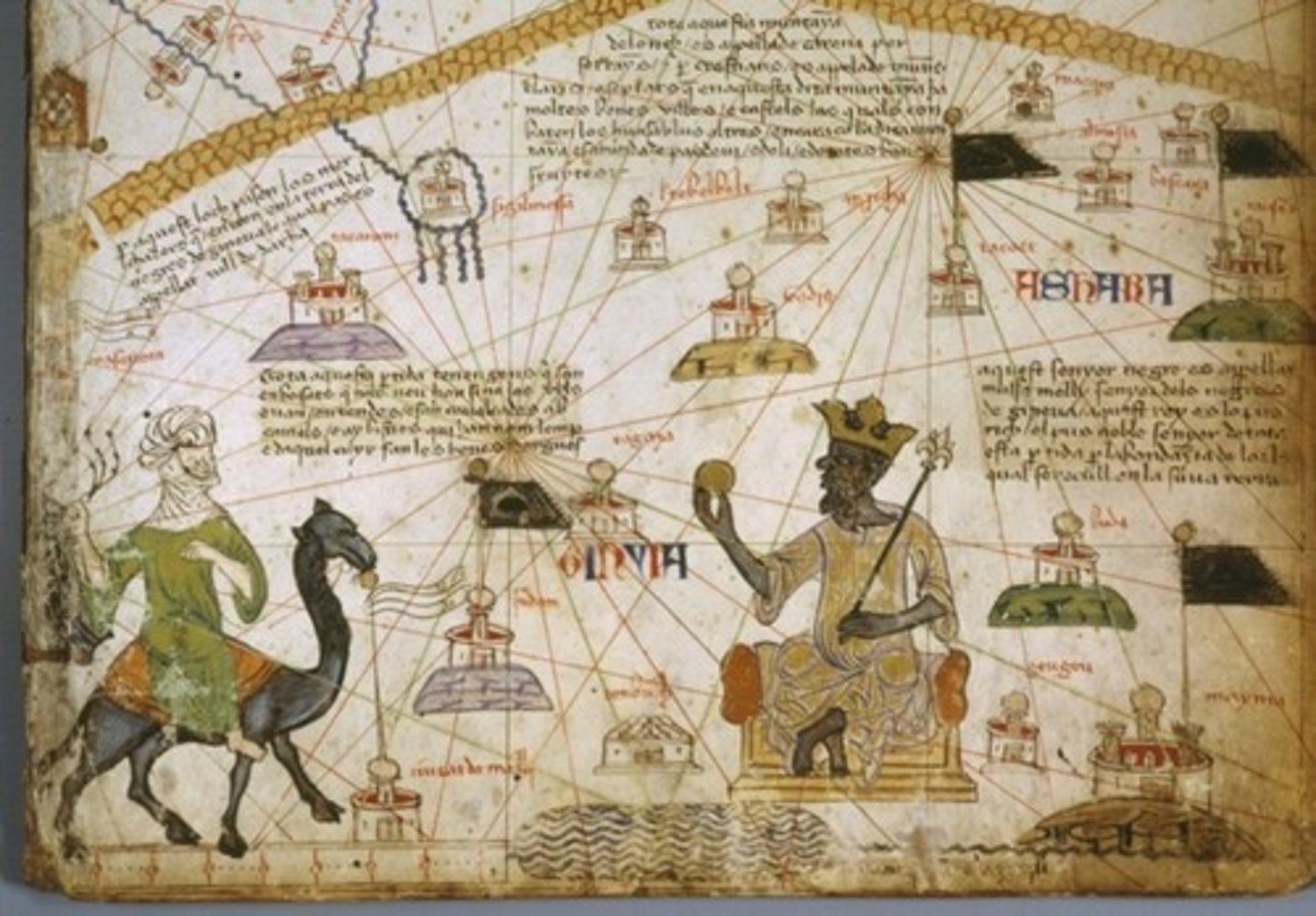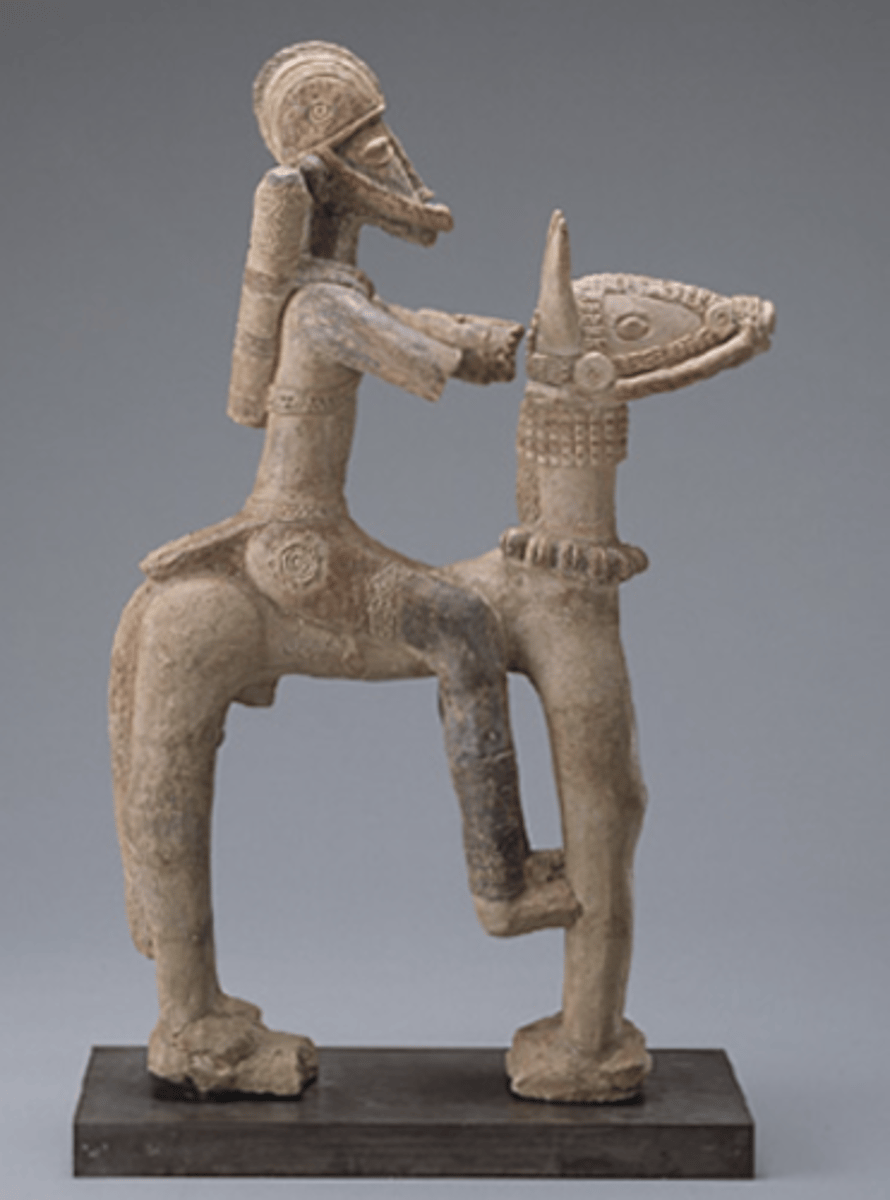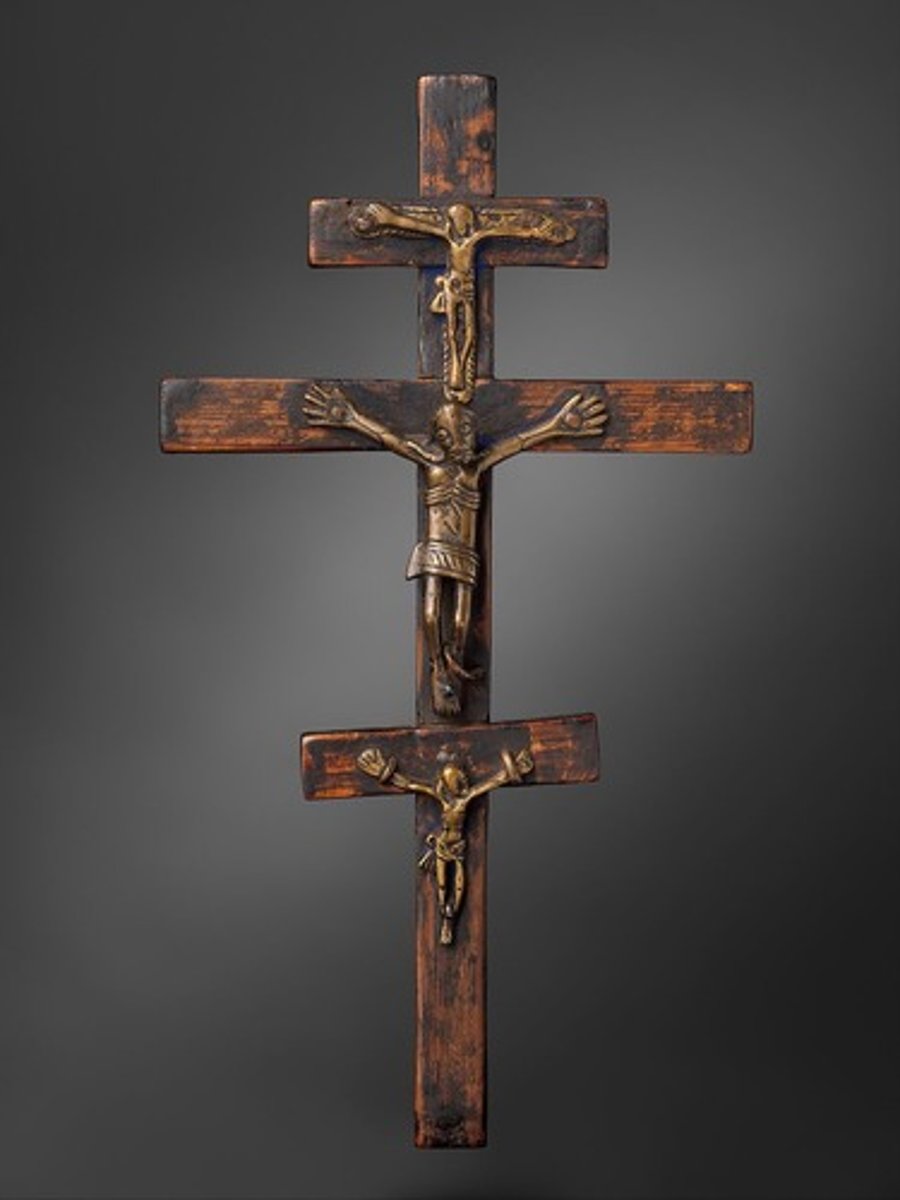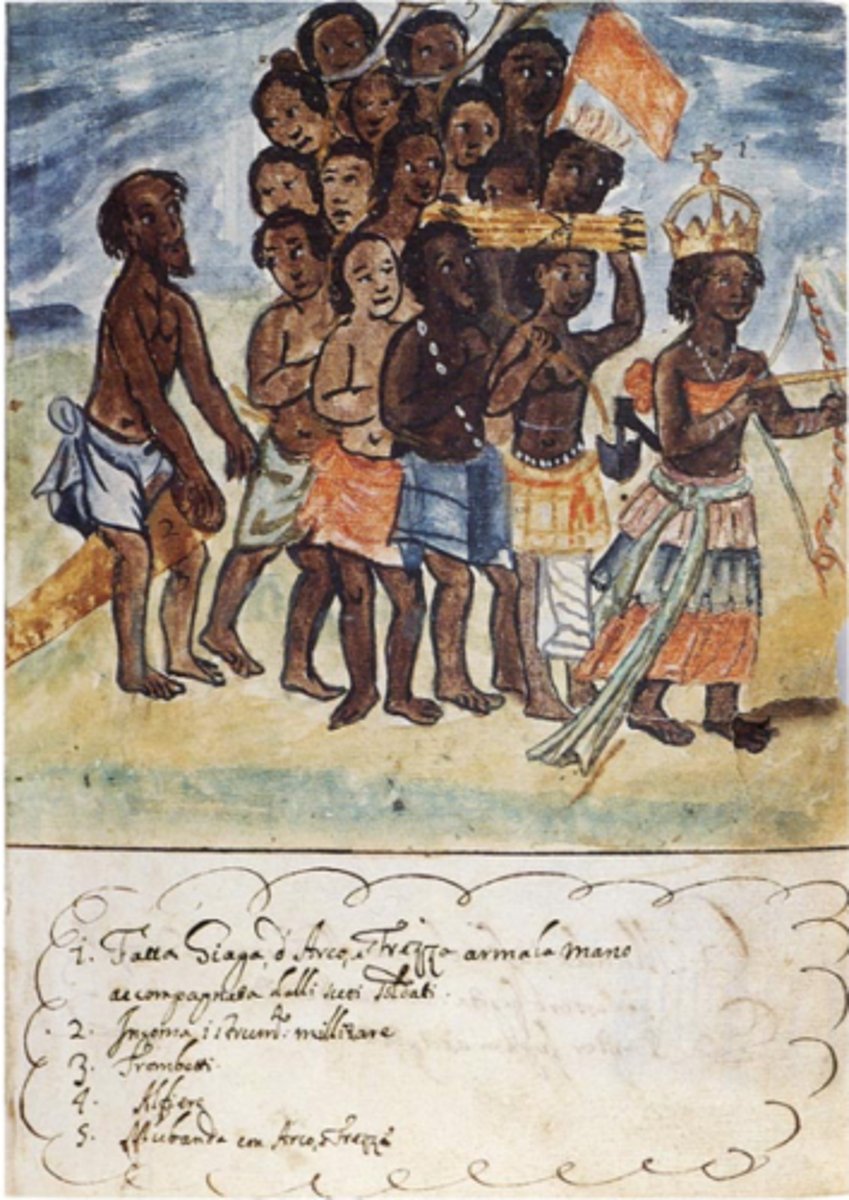AP AFAM - Unit 1
1/59
Earn XP
Description and Tags
Name | Mastery | Learn | Test | Matching | Spaced | Call with Kai |
|---|
No study sessions yet.
60 Terms
What is African American studies?
- Combines interdisciplinary approach with scholarly inquiry
- Analyzes history, culture, and contributions of people of African descent in U.S. and throughout African diaspora
What does the term "African Diaspora" refer to?
The global dispersion of people of African descent (particularly those who were forcibly enslaved and taken from Africa during the transatlantic slave trade).
What was the result of this dispersal?
Millions of Africans migrated to various parts of the world (the Americas, Europe, the Caribbean, & other parts of the African continent).
The National Council for Black Studies (NCBS)
Created in 1975 during the National Black Studies Conference
-> African American scholars came together to formalize study of African diasporic experience + expand and strengthen academic units and community programs devoted to this cause
Medicine and Transportation
- Thelma Johnson Streat (1942 - 1944)
- Acknowledged & celebrated African American contributions to the fields of medicine and transportation
Outcast
- Poem by Claude McKay (1922)
- Speaks of despair and isolation he feels in U.S.
- His spirit wants to return to his homeland but his body is held in bondage to colonial history
What type of continent is Africa?
- A diverse continent
- Full of different cultures, languages, histories, and societies
- Second largest continent, comprising 54 countries & numerous territories + regions
How is Africa culturally diverse?
- Africa home to many ethnic groups (more than 2000), each with its unique traditions, customs, and languages
- Diversity can be seen in clothing, music, dance, art, cuisine, social structures, religious practices
How is Africa linguistically diverse?
- Around 2,100 different languages
- Some countries have multiple official languages due to the linguistic diversity within their borders
(EX: Zimbabwe has 16 official languages)
How is Africa geographically diverse?
- Landscapes include deserts (like Sahara and Kalahari), savannas, rainforests, mountains, and coastal regions
- This diversity has shaped different societies and their ways of life
What is the historical and archaeological significance of Africa?
- Earliest evidence of human ancestors found in Africa
- Has complex history of ancient civilizations, such as Ancient Egypt, Mali, and the Timbuktu --> contributed to the development of mathematics, architecture, writing systems
What were the Trans-Saharan trade routes?
- Connected northern regions of Africa to the Mediterranean world and the Middle East
- Facilitated exchange of gold, ivory, salt, textiles, and slaves, across Sahara Desert
What was the Indian Ocean Trade?
- Coastal regions of East Africa were engaged in maritime trade with India, the. Middle East, and as far as China
- Facilitated exchange of spices, textiles, ceramics, precious metals
What are Africa's primary climate zones?
- Desert (the Sahara)
- Semiarid (the Sahel)
- Savanna grasslands
- Tropical rainforests
- The Mediterranean zone
What was the significance of Africa's proximity to the Red Sea, Mediterranean Sea, and Indian Ocean?
Supported the emergence of early societies & fostered early global connections beyond the continent
How did variations in climate facilitate diverse opportunities for trade?
- Desert & Semiarid Areas: herders nomadic, moving in search of food and water, and some traded salt
- Sahel: people traded livestock
- The Savannas: people cultivated grain crops
- Tropical Rainforests: people grew kola trees and yam and traded gold
What contributed to the growth of West and Central African peoples?
Technological innovations (tools and weapons) and agricultural innovations (cultivating bananas, yams, and cereals)
Bantu Expansion
- A series of migrations throughout the African continent, from 1500 BCE to 500 CE
- Bantu peoples were growing, so they needed more land to grow crops and raise livestock --> led them to search for new land in other parts of Africa
What were some technological innovations of the Bantu peoples?
Ironworking and agriculture
--> Gave them an advantage over other groups, making it easier for them to expand their territory
How did the Bantu expansion affect the linguistic diversity of West and Central Africa?
- Bantu-speaking peoples' linguistic influences spread throughout Africa
- Today, Bantu linguistic family includes hundreds of languages that are spoken throughout West, Central, and Southern Africa (e.g., Xhosa, Swahili, Kikongo, Zulu)
What were some of the world's earliest complex, large-scale societies that arose in Africa during the ancient era?
- Egypt
- Nubia (or Kush/Cush)
- Aksum in East Africa
- Nok society in West Africa
Egypt
- One of the earliest civilizations in world history
- Had a mixture of racial features and language
- Began farming instead of hunting and Egypt united under the first pharaoh
--> The Old Kingdom (3200 to 2050 B.C.)
Nubia: Kush (Meroe)
- Ancient region of Nubia in South of Egypt (Sudan today)
- Nubia is a region along the Nile river
- Nubians established kingdom of Kush after decline of Egypt
- Meroe: capital city of Kingdom of Kush
- Kushites took control of Egypt in 8th century BCE
- Kush independent for 1000 years
- One of the richest gold-bearing areas (had international trade relations that made them very wealthy)
- Kushites migrated, taking concepts of state organization and specialized skills with them
Aksum
- First African society to adopt Christianity under King Ezana
- Ge'ez, its script, still used as main liturgical language of the Ethiopian Orthodox Church
- Aksumite Empire exemplifies African societies that adopted Christianity on their own terms, beyond influence of colonialism or the later transatlantic slave trade.
Nok Society
- West Africa's earliest known culture
- Lived in present-day Nigeria between 500 B.C. and A.D. 200
- Earliest iron-working society
Nok Sculptures (Terracotta Sculptures)
- Common features: naturalistic sculptures of animals, sculptures of people with various hairstyles and jewelry
- Similarity of Nok sculptures to the brass terracotta works of the Ife Yoruba and Benin cultures suggests that the Nok society may be their early ancestor
Why were the works of African American writers significant?
- From late 18th century onward, African American writers emphasized significance of ancient African societies
--> countered racist stereotypes that African societies lacked government and culture
- By mid-20th century, knowledge of complexity & contributions of Africa's ancient societies formed basis for Africans' political claims for self-rule and independence from European colonialism
Ghana (300 - 1076 CE)
- Power from commerce/trade
- Ghana's kings rich
- Controlled trans-Saharan trade route (key was the Asian camel - long journeys with little water)
- Exported pepper, gold, and the enslaved (usually war captives)
- After the Romans, Muslims dominated and introduced Arabic writing
- Ghana was conquered in 1240 and became part of the Mali empire
Mali (1230 - 1468 CE)
- Present-day countries of Mali empire: Mali, Gambia, Guinea, Côte d'Ivoire, Senegal, Niger, and Mauritania
- Sundiata defeated Ghana and created the Empire of Mali and gained control of the gold mines
- Mali's emperors converted to Islam --> gained stature among Arab states
- Mali's most important city was Timbuktu
a) Major hub for trade in gold, the enslaved, and salt
b) Featured the Sankore Mosque (first African university)
c) Leading center of Islamic learning (several mosques, 150 schools, law school, and book dealers)
Who was Mansa Musa?
- One of the wealthiest rulers the world has ever known (built wealth from gold and salt mines)
- Mali reached its peak during his reign (1312 - 1337)
- Made himself and Mali famous when he undertook an extravagant pilgrimage to the holy city of Mecca in Arabia
- Built what would become the University of Timbuktu, established the empire as a center for trade, learning, and cultural exchange.
- After his death, Mali declined
Songhai (1464 - 1591)
- Songhai were great traders and warriors
--> freed themselves from Mali in 1375
- Sunni Ali founded the largest west Sudanese empire (Songhai)
- When Sunni Ali died, Askia Muhammad Toure led a revolt to become king, and spread the influence of Islam
- During a pilgrimage to Mecca, Toure recruited scholars to serve at Sankore Mosque (University of Timbuktu)
- This mosque became known as a center for the study of theology, law, mathematics, and medicine
Where was ancient Ghana located?
In present-day Mauritania and Mali
-->. Present-day Republic of Ghana embraced the name of the ancient empire when it achieved independence from colonial rule (1957)
Catalan Atlas by Abraham Cresques, 1375
- Details wealth and influence of Mansa Musa and the Mali Empire based on the perspective of a cartographer from Spain
- Mansa Musa adorned with gold crown and orb
- Conveys influence of Islam on West African societies and the function of Mali as a center for trade and cultural exchange

Mali Equestrian Figure, 13th - 15th century
- Bearded, helmeted, and armed equestrian (related to horse riding) figure
- The quiver on the rider's back was representative of royal power

Who were the Mande griots/the jeli?
- A historian, advisor, arbitrator,praise singer, and storyteller
- Passed down oral traditions for centuries
Epic of Sundiata
- Recounts early life of Sundiata Keita (the "lion prince"), founder of the Mali Empire
- Preserves early history of Mande people
- Instruments used: the balafon, kora, the khalam (or xalam), the ngoni, the kontigi, the goje
Kingdom of Zimbabwe and its Success
- Kingdom of Zimbabwe and its capital city, Great Zimbabwe, flourished in Southern Africa from 12th - 15th century
- Linked to trade on the Swahili Coast
- Its inhabitants, the Shona people, became wealthy from its gold, ivory, & cattle resources
What is Great Zimbabwe known for?
- Known for its large stone structure, which offered military defense and served as a hub for long-distance trade
- The Great Enclosure - a site for religious and administrative activities
- The conical tower likely served as a granary (storehouse for threshed grain)
- The stone ruins remain important symbol of prominence, autonomy, and agricultural advancements of Shona kings and early African societies such as Great ZImbabwe
The Swahili Coast's Geography
- Stretched from Somalia to Mozambique
- The coastal location of its city-states linked Africa's interior to the Arab, Persian, Indian, and Chinese trading communities
What united the Swahili Coast city-states?
Between 11th & 15th centuries, united by their shared language (Swahili), and shared religion (Islam)
What was the result of the Swahili Coast's success?
- Strength of Swahili Coast trading states garnered the attention of the Portuguese
- Portuguese invaded major city-states and established settlements in the 16th century to control Indian Ocean Trade
Kingdom of Kongo's Conversion
In 1491, King Nzinga a Nkuwu (João I) and his son Nzinga Mbemba (Afonso I) voluntarily converted Kingdom of Kongo to Roman Catholicism
What was the result of the Kingdom of Kongo's conversion to Christianity?
- Strengthened its trade relationships with Portugal, leading to Kongo's increased wealth
(Ivory, salt, copper, and textiles were the primary goods of trade)
- King of Portugal demanded access to the trade of enslaved people in exchange for military assistance
Why were Christian names common among early African Americans?
- In Kongo, the practice of naming children after saints or according to the day of the week on which they were born ("day names") was common before the rise of the Atlantic slave trade
- About 1/4 of enslaved Africans directly transported to what became the U.S. from West Central Africa --> Many of them were Christians before they arrived in the Americas
Letter from Nzinga Mbemba to Portuguese King João III, 1526
- Wrote this when Portuguese were purchasing illegally enslaved people and then exporting them
- Asks King João III to respect their alliance
Triple Crucifix, 16th - 19th century
Illustrates how people of Kongo engaged with Christian belief and with the European artistic forms that arrived in their land with the new religion

Syncretic
Practice of combining different beliefs and various schools of thought
Cosmologies
The science of the origin and development of the universe
Syncretism in African Societies
Adoption of Islam (e.g., in Mali and Songhai) or of Christianity (e.g., in Kongo) resulted in the blending of these introduced faiths with indigenous spiritual beliefs and cosmologies
How did syncretic religious and cultural practices from Africa reach the Americas?
- Africans who blended indigenous spiritual practices with Christianity and Islam brought their syncretic religious and cultural practices from Africa to the America
What are some spiritual practices that can be traced back to West Africa?
- Veneration of ancestors, divination, healing practices, and collective singing and dancing
--> These practices have survived in African diasporic religions, including:
a) Louisiana Voodoo
b) Vodun, in Haiti
c) Regla de Ocha-Ifa (once known as santería), in Cuba
d) Candomblé, in Brazil
How were West African Spiritual practices used to express resistance?
Africans and their descendants who were later enslaved in the Americas often performed spiritual ceremonies of these syncretic faiths to strengthen themselves before leading revolts
Osain del Monte
- Worshipped by some as the "owner of nature," a saint of the Yoruba religion
- Spiritual songs worshipping him used in ceremonies of consecration and purification
What roles did women play in West and Central African societies?
- Spiritual leaders
- Political advisors
- Market traders
- Educators
- Agriculturalists
Queen Idia
- Led armies into battle
- Relied on spiritual power and medicinal knowledge to bring victories to Benin
Queen Njinga
- Engaged in 30 years of guerrilla warfare against Portuguese to maintain sovereignty
and control of her kingdom
- Participated in slave trade to amass wealth and political influence
- Expanded Matamba's military by offering sanctuary for those who escaped Portuguese enslavement and joined her forces
- Strength of her reign led to 100+ years of female rulers in Matamba

Cabo Verde and São Tomé
- In the mid-15th century, Portuguese colonized the Atlantic islands of Cabo Verde and São Tomé
- Here, they established cotton, indigo, and sugar plantations using labor of enslaved Africans
Portuguese-colonized Atlantic Islands
- By 1500, ~ 50,000 enslaved Africans removed from the continent to work on Portuguese-colonized Atlantic islands and in Europe
- These plantations became a model for slave-based economies in the Americas
Mediterranean Port Cities
- African elites, including ambassadors and the children of rulers, traveled to Mediterranean port cities for diplomatic, educational, and religious reasons
- In these cities, free and enslaved Africans also served in roles ranging from domestic labor to boatmen, guards, entertainers, vendors, and knights
Chafariz d'El Rey (The King's Fountain), 1570-1580
- Illustrates substantial presence of Africans and the range of roles they played in urban Iberian port cities in the 16th century
- Shows the interchange between African and European societies well before the height of the transatlantic slave trade
